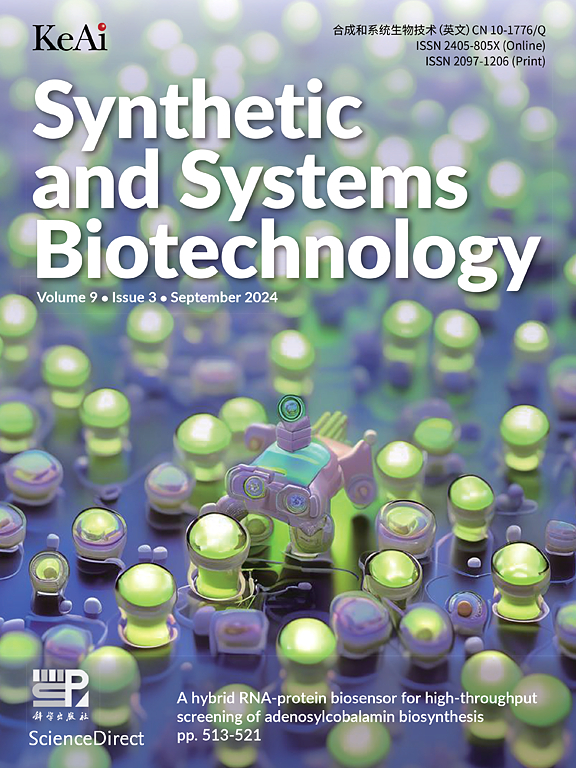Coupling genome-wide continuous perturbation with biosensor screening reveals the potential targets in yeast isopentanol synthesis network
IF 4.4
2区 生物学
Q1 BIOTECHNOLOGY & APPLIED MICROBIOLOGY
引用次数: 0
Abstract
The increasing consumption of fossil fuels is contributing to global resource depletion and environmental pollution. Branched-chain higher alcohols, such as isopentanol and isobutanol, have attracted significant attention as next-generation biofuels. Biofuel production through microbial fermentation offers a green, sustainable, and renewable alternative to chemical synthesis. While enhanced production of isopentanol has been achieved in a variety of chassis, the fermentation yield has not yet reached levels suitable for industrial-scale production. In this study, we employed a continuous perturbation tool to construct a genome-scale perturbation library, combined with an isopentanol biosensor to screen for high-yielding mutants. We identified five high-yielding mutants, each exhibiting an increased glucose conversion rate and isopentanol titer. The F2 strain, in particular, achieved an isopentanol titer of 1.57 ± 0.014 g/L and a yield of 14.04 ± 0.251 mg/g glucose (10% glucose), surpassing the highest values reported to date in engineered Saccharomyces cerevisiae. Systematic transcriptome analysis of the isopentanol synthesis, glycolysis, glycerol metabolism, and ethanol synthesis pathways revealed that MPC, OAC1, BAT2, GUT2, PDC6, and ALD4 are linked to efficient isopentanol production. Further analysis of differentially expressed genes (DEGs) identified 17 and 12 co-expressed DEGs (co-DEGs) in all mutants and the two second-round mutants, respectively. In addition, we validated the knockout or overexpression of key co-DEGs. Our results confirmed the critical roles of HOM3 and DIP5 in isopentanol production, along with genes associated with the aerobic respiratory chain (SDH3, CYT1, COX7, ROX1, and ATG41) and cofactor balance (BNA2 and NDE1). Additionally, functional analysis of the co-DEGs revealed that MAL33 is associated with the synthesis of branched-chain higher alcohols, expanding the intracellular metabolic network and offering new possibilities for green, cost-effective biofuel production.

将全基因组连续扰动与生物传感器筛选相结合,揭示了酵母异戊醇合成网络中的潜在靶点
化石燃料消费的增加正在造成全球资源枯竭和环境污染。支链高等醇,如异戊醇和异丁醇,作为下一代生物燃料引起了极大的关注。通过微生物发酵生产生物燃料为化学合成提供了一种绿色、可持续和可再生的替代方法。虽然在各种底盘上提高了异戊醇的产量,但发酵产量尚未达到适合工业规模生产的水平。在这项研究中,我们采用连续扰动工具构建了一个基因组尺度的扰动文库,并结合异戊醇生物传感器筛选高产突变体。我们确定了五个高产突变体,每个突变体都表现出葡萄糖转化率和异戊醇滴度的增加。特别是F2菌株,其异戊醇滴度为1.57±0.014 g/L,葡萄糖产量为14.04±0.251 mg/g(10%葡萄糖),超过了迄今为止报道的工程酿酒酵母的最高值。对异戊醇合成、糖酵解、甘油代谢和乙醇合成途径的系统转录组分析显示,MPC、OAC1、BAT2、GUT2、PDC6和ALD4与高效的异戊醇生产有关。进一步分析差异表达基因(DEGs),在所有突变体和两个第二轮突变体中分别鉴定出17个和12个共表达的DEGs (co-DEGs)。此外,我们验证了敲除或过表达关键的co- deg。我们的研究结果证实了HOM3和DIP5在异戊醇生产中的关键作用,以及与有氧呼吸链相关的基因(SDH3、CYT1、COX7、ROX1和ATG41)和辅助因子平衡(BNA2和NDE1)。此外,对共deg的功能分析表明,MAL33与支链高级醇的合成有关,扩大了细胞内代谢网络,为绿色、经济高效的生物燃料生产提供了新的可能性。
本文章由计算机程序翻译,如有差异,请以英文原文为准。
求助全文
约1分钟内获得全文
求助全文
来源期刊

Synthetic and Systems Biotechnology
BIOTECHNOLOGY & APPLIED MICROBIOLOGY-
CiteScore
6.90
自引率
12.50%
发文量
90
审稿时长
67 days
期刊介绍:
Synthetic and Systems Biotechnology aims to promote the communication of original research in synthetic and systems biology, with strong emphasis on applications towards biotechnology. This journal is a quarterly peer-reviewed journal led by Editor-in-Chief Lixin Zhang. The journal publishes high-quality research; focusing on integrative approaches to enable the understanding and design of biological systems, and research to develop the application of systems and synthetic biology to natural systems. This journal will publish Articles, Short notes, Methods, Mini Reviews, Commentary and Conference reviews.
 求助内容:
求助内容: 应助结果提醒方式:
应助结果提醒方式:


